
Kadhimiya or Kadhimayn is a northern neighbourhood of the city of Baghdad, Iraq. It is about 5 kilometres (3.1 mi) from the city's center, on the west bank of the Tigris. 'Kadhimiya' is also the name of one of nine administrative districts in Baghdad. As the place of al-Kadhimiya Mosque, even before its inception into the urban area of Baghdad, it is regarded as a holy city by Twelver Shia muslims.

Stari Grad is a municipality of the city of Sarajevo, Bosnia and Herzegovina. It is the oldest and most historically significant part of Sarajevo. At its heart is the Baščaršija, the old town market sector where the city was founded by Ottoman general Isa-Beg Ishaković in the 15th century.

Gazi Husrev-beg Mosque is a mosque in the city of Sarajevo, Bosnia and Herzegovina. Built in the 16th century, it is the largest historical mosque in Bosnia and Herzegovina and one of the most representative Ottoman structures in the Balkans. Having been Sarajevo's central mosque since the days of its construction, today it also serves as the main congregational mosque of the Muslims in Bosnia and Herzegovina. It is located in the Baščaršija neighbourhood in the Stari Grad municipality and, being one of the main architectural monuments in the town, is regularly visited by tourists.

Türbe refers to a Muslim mausoleum, tomb or grave often in the Turkish-speaking areas and for the mausolea of Ottoman sultans, nobles and notables. A typical türbe is located in the grounds of a mosque or complex, often endowed by the deceased. However, some are more closely integrated into surrounding buildings.
The architecture of Bosnia and Herzegovina is largely influenced by four major periods, when political and social changes determined the creation of distinct cultural and architectural habits of the region.

Tourism in Bosnia and Herzegovina is a fast-growing sector making up an important part in the economy of the country.
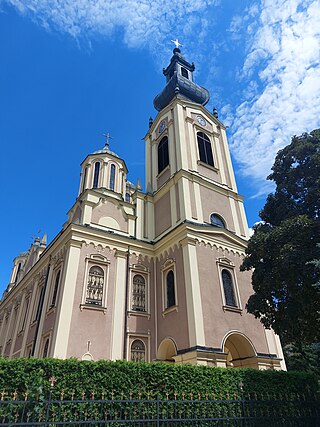
The Cathedral Church of the Nativity of the Theotokos is the largest Serbian Orthodox church in Sarajevo and one of the largest in the Balkans. The cathedral is designated National Monument of Bosnia and Herzegovina by the KONS.

Art of Bosnia and Herzegovina refers to artistic objects created by the inhabitants of Bosnia and Herzegovina from prehistory to present times.
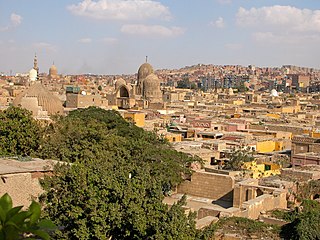
The City of the Dead, or Cairo Necropolis, also referred to as theQarafa, is a series of vast Islamic-era necropolises and cemeteries in Cairo, Egypt. They extend to the north and to the south of the Cairo Citadel, below the Mokattam Hills and outside the historic city walls, covering an area roughly 4 miles (6.4 km) long. They are included in the UNESCO World Heritage Site of "Historic Cairo".
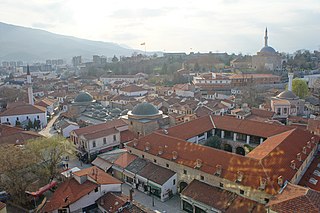
The Old Bazaar also known as Turkish Bazaar is a bazaar located in Skopje, North Macedonia, situated on the eastern bank of the Vardar River, stretching from the Stone Bridge to the Bit-Pazar and from the Skopje Fortress to the Serava river. The Old Bazaar falls primarily within the borders of Čair Municipality but a part of it is located in Centar Municipality. As one of the oldest and largest marketplaces in the Balkans, it has been Skopje's centre for trade and commerce since at least the 12th century.

The Goat's Bridge is a large stone bridge that crosses the Miljacka river to the east of Sarajevo, Bosnia and Herzegovina.
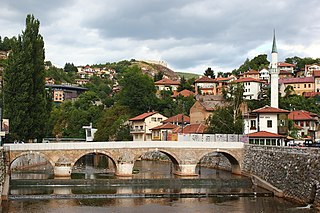
Babića bašča is a local community within the municipality of Stari Grad, Sarajevo. It's one of the oldest neighborhoods in the city of Sarajevo. It derives its name from a garden that was the property of a certain Babić family, and it was located in a street that now has the same name as the local community. The reason why it's named after a garden is that because almost all houses had gardens in their courtyards and in summer, many people who traveled through Sarajevo in the past, described Sarajevo as a green oasis surrounded by hills, making those gardens something as a symbol of the city. The street and old cemetery Alifakovac is located here and therefore the neighborhood is locally and throughout the city known as Alifakovac. It borders the local communities of Baščaršija, Vratnik and Mošćanica to the north, Hrid – Jarčedoli to the south, Bistrik to the west and the Entity of Republika Srpska to the east. The local community counts a population of 1,496.

The architecture of Albania is a reflection of Albania's historical and cultural heritage. The country's architecture was influenced by its location within the Mediterranean Basin and progressed over the course of history as it was once inhabited by numerous civilisations including the Illyrians, Ancient Greeks, Romans, Byzantines, Venetians, Ottomans as well as modern Austro-Hungarians and Italians. In addition, missionaries, invaders, colonisers and traders brought cultural changes that had a large profound effect on building styles as well as techniques.
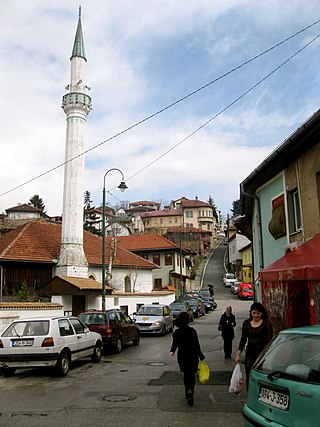
The Vekil-Harrach or Hadžijska mosque is a mosque in the city of Sarajevo, Bosnia and Herzegovina. It is located in Alifakovac, a neighborhood in Babića bašća local community, one of the oldest urban settlements in Sarajevo.

Vratnik, also known as Stari grad Vratnik, is one of the oldest neighbourhoods in Sarajevo, Bosnia and Herzegovina.

The Mouassine Mosque or al-Muwassin Mosque is a major neighbourhood mosque in Marrakech, Morocco, dating from the 16th century during the Saadian dynasty. It shares its name with the Mouassine neighbourhood.

The Aladža Mosque, also known as Šarena džamija, "Colorful Mosque", is an Ottoman era mosque that was built in 1549 and located in Foča, Bosnia and Herzegovina. It is considered one of the most beautiful and important examples of Ottoman architecture in Europe, and is one of the most important Ottoman era mosques in all of Bosnia and Herzegovina; along with the Gazi Husrev-beg Mosque in Sarajevo and the Ferhadija Mosque in Banja Luka. It was completely destroyed with pre-planted explovises at the beginning of the Bosnian War in 1992 by the VRS, and levelled to the ground; along with the left over stones and rubble from the mosque being hidden all over Foča to prevent its reconstruction. After many years of searching for the stones once the Bosniak refugees of Foča began to return, and sourcing the funds necessary for the reconstruction of the mosque, its reconstruction was started in 2016, and completed in 2018.
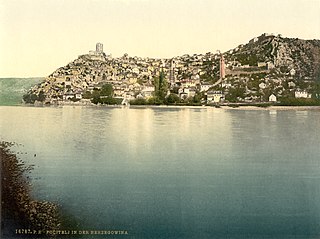
Walled town of Počitelj is a medieval fortified nucleus of Počitelj historic village, in the municipality of Čapljina, Bosnia and Herzegovina. Due to its significant architectural and urbanistic historical value, it is considered an open-air museum. The Walled town is nested in a natural karst amphitheater along the left bank of the Neretva river, on the main road Mostar-Metković. The walled nucleus is protected as a National Monument of Bosnia and Herzegovina. The architectural ensemble of Počitelj is also proposed as such for inscription into the UNESCO's list of World Heritage Sites. The bid for inscription is currently placed on the UNESCO Tentative list.

















